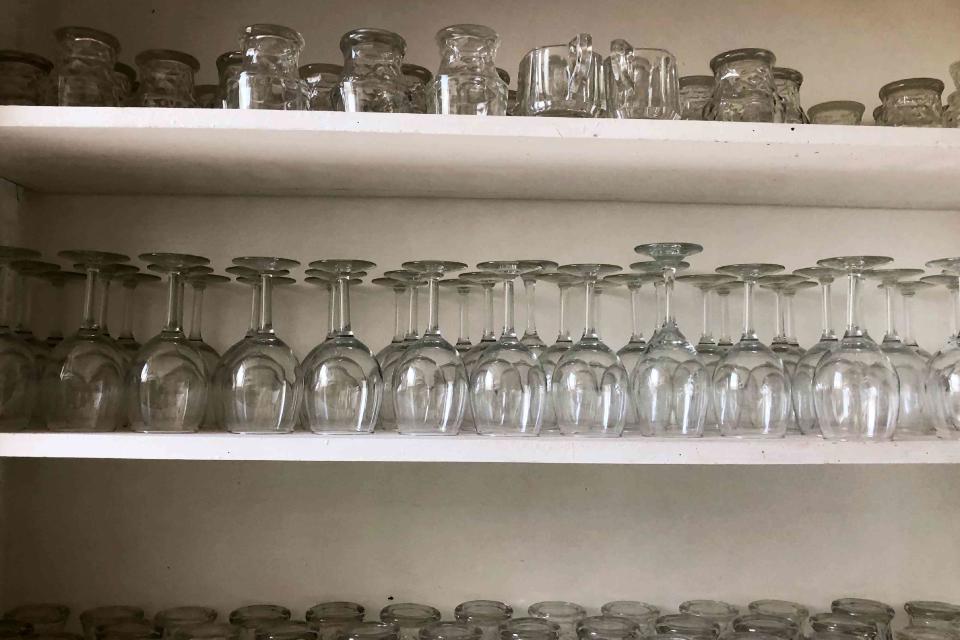Do You Store Your Glasses Right Side Up or Are You Doing It Wrong?
We consulted some experts and got some great advice — and some weird stuff, too.

Luke Yost / Getty Images
Hi, you don't know me, but may I please store some glassware at your house? I promise I'll place it in the right direction, which is whatever that happens to mean in your particular home because I really have no particular feelings on the matter, just habits — but other people do. Oh, they really do, and I'm so happy for them. It's great to have emotional investment in matters of the household (so long as you're not a militant weirdo about it and don't use it as an excuse to rain terror upon and insult people who were raised differently from you) because it shows you still have the capacity to care about something, and that's lovely.
Related: Do You Leave Butter Out on the Counter or Keep It in the Fridge?
I ask about the glassware because I have so, so, so much of it, and the thing I have chosen to be pleasurably fussy about is enjoying a cordial in a cordial glass, cognac in a snifter, a Sidecar in a coupe, a Manhattan in a Nick and Nora, a Tom Collins in a Collins glass and so on. My cabinets are filled to bursting, yet I cannot stop buying it. I'm also creepily passionate about old housekeeping and etiquette books, and the advice therein, so when my colleagues were having a rousing discussion about the right way to store glassware — with the rim facing up or down — I went running pell-mell to my bookshelves.
"Let the dish-pan be half full of hot soap and water. Wash glass first, paying no attention to the old saying that "hot water rots glass." Be careful never to put glass into hot water, bottom first, as the sudden expansion may crack it. Slip it in edgeways, and the finest and most delicate cut-glass will be safe. — Helen Campbell"
"The Easiest Way in Housekeeping and Cooking" (1893)
In addition to retroactively unnerving counsel on patching your china with white lead and polishing glassware with fuller’s earth, the consensus amongst self-proclaimed housekeeping experts and authors of books like Domestic Cookery, Useful Receipts, and Hints to Young Housekeepers and The Cook and Housekeeper's Complete and Universal Dictionary; Including a System of Modern Cookery, in all Its Various Branches, Adapted to the Use of Private Families is that the storage orientation should generally be dictated by two things: the frequency of use of each kind of glassware, and the kind of shelving you have.
Should your shelves happen to be behind doors, which shield the items therein from dust, bugs, spatter, and the like, rim-side-up is fine. Just make a point of ensuring that they're thoroughly dry before they're stashed and visually inspecting the less frequently used glasses for dust and vermin, giving them a quick dust or rinse before you deploy them. (And also make sure you're using a properly clean cloth because as you'd imagine, these domestic auteurs had a LOT of feelings about that — or rather how their servants ought to be addressing the issue of napery sanitation.)
"When the dishes have been made ready for washing, pour a generous supply of hot water into the dishpan. Put into it a little borax, or a larger supply if the water is hard. Lay in two or three glasses. They should be put in edge first, wet inside and out at the same moment, and not laid close enough to touch each other. Take them out one at a time and immediately wipe them dry and bright. They become streaked if allowed to drain. Replace those taken out with others to be washed. Set the wiped glasses in a space prepared for them on a shelf or table, or if there is little room in the pantry put them on a tray which can be carried at once to the cupboard. — Elizabeth Hale Gilman"
"The Library of Work and Play: Housekeeping" (1911)
If you've got the ever so Instagram-friendly open shelving, rim-side-down may be the better option (especially for that schnapps or absinthe or Tom and Jerry glass you bust out once a year and shut up, I'm a collector, not a hoarder), but for purposes of both airflow and protection of delicate glass, it's worth investing in spongy shelf liners, or at the very least a couple layers of paper towels. Your IKEA mug might be able to take a beating, but that ungodly expensive Zalto Burgundy glass you got as a gift and are too terrified to actually deploy might nick if you look at it sideways, and you don't want to have to bust out the white lead. (Ed note: Lead is bad for you and so is asbestos, which one of these ancient tomes also suggested as a great placemat for hot dishes.)
Related: The Best Wine Glasses for Every Grape Variety, According to Experts
There's only one person I personally know who is as fixated on glassware specificity as I am and that's my friend John Winterman who owns Francie restaurant, and has worked at some of the schmanciest places on the planet. Spots and chips are anathema to him and he says: "It depends on where they are being stored and how often the glasses are being used. At Francie we keep the glasses stored out on shelves upside down, in cabinets they are upside right. At home I store them in cabinets but always with a quick polish before usage."
But you do you — so long as you let me stash a couple snifters at your house.
For more Food & Wine news, make sure to sign up for our newsletter!
Read the original article on Food & Wine.

